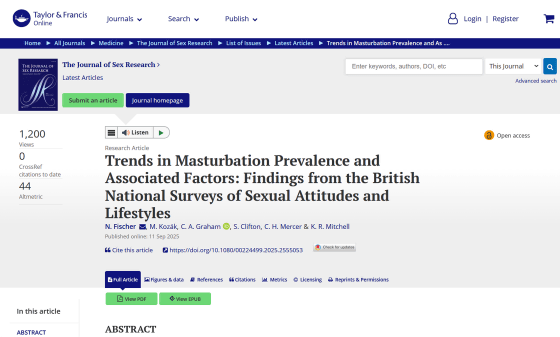Research results show that 'masturbation is increasing for both men and women'

A new study analyzing more than 10 years of data, including how often people masturbate, has found that masturbation rates increased for both men and women between the early 2000s and the early 2010s.
Full article: Trends in Masturbation Prevalence and Associated Factors: Findings from the British National Surveys of Sexual Attitudes and Lifestyles

New research reveals masturbation is on the rise and challenges old ideas about its role
https://www.psypost.org/new-research-reveals-masturbation-is-on-the-rise-and-challenges-old-ideas-about-its-role/
Masturbation is not just for men, but for many years it was thought of as a substitute for men who are unable to have sex with their partner, while women's masturbation was seen as a complementary activity to active sexual partners.
However, in modern times, changes in social attitudes and environments regarding sex and masturbation have led to growing calls to question this gender-based framework, and it has also been pointed out that there is a lack of robust, large-scale research on masturbation, making it difficult to discern clear trends.
A research team from the UK and Norway analyzed data from the second and third waves of the National Survey of Sexual Attitudes and Lifestyles conducted in the UK. This is a large-scale survey designed to be representative of the general UK population. Wave 2 was conducted between 1999 and 2001, with 11,161 participants aged 16 to 44. Wave 3 was conducted between 2010 and 2012, with 15,162 participants aged 16 to 74.
Respondents were interviewed in their homes by trained interviewers, and sensitive questions about masturbation and other topics were self-administered via computer. To directly compare data from Waves 2 and 3, the researchers analyzed only data from those aged 16 to 44.

The analysis revealed a statistically significant increase in the percentage of people who answered 'I masturbated in the past month' from Wave 2 to Wave 3. Specifically, among women, the percentage of people who masturbated in the past month increased from 37.0% in Wave 2 to 40.3% in Wave 3. Similarly, among men, the percentage increased from 73.4% in Wave 2 to 77.5% in Wave 3. Furthermore, the percentage of women who answered 'I have never masturbated in my life' also decreased from 28.5% in Wave 2 to 24.1% in Wave 3.
The percentage of people who had masturbated in the past month increased significantly, especially among younger people aged 16 to 24. Looking at relationship status, both men and women with casual or stable partners showed a tendency for masturbation to increase. Meanwhile, no significant difference was observed between waves 2 and 3 among those without partners. The research team suggests that broader cultural changes, such as increased access to static content on the internet, that occurred between waves 2 and 3 may have influenced patterns of sexual behavior.
Furthermore, the research team used data from respondents aged 16 to 74 in the third wave to explore the relationship between masturbation and sociodemographic, health, relationship status, and other factors. They found that men who have more frequent sex are less likely to masturbate, while women who have more frequent sex are more likely to masturbate. Looking at these results alone, it seems that traditional gender roles regarding masturbation are still alive and well.
However, when taking into account respondents' satisfaction with and desire for sex, more complex results emerged. The percentage of those who reported masturbating in the past month was higher among both men and women who thought they wanted more sex than they do now. Furthermore, those who felt their sexual interest levels differed from their partners, those who were dissatisfied with their sex lives, and those who felt pain or anxiety about their sex lives also had a higher percentage of those who reported masturbating. Similarly, men and women who reported experiencing sexual difficulties, and women whose partners experienced sexual difficulties, were also more likely to have masturbated in the past month.
These results contradict conventional theories that suggest that masturbation serves as a substitute for partnered sex when it is not possible to have sex, not only for men but also for women, when sexual activity with a partner is a source of dissatisfaction or a challenge.

This analysis also showed that for both men and women, the younger the age, the higher the percentage of those who had masturbated in the past month, and that those who emphasize religious beliefs were less likely to masturbate. It also showed that gay, lesbian, and bisexual people were more likely to masturbate than heterosexuals, and that those with more sexual partners in the past year were more likely to masturbate.
Personal beliefs were also associated with masturbation frequency: those who believed that 'sex without love is acceptable' were more likely to have masturbated in the past month, while those who believed that 'the desire for sex decreases with age' were less likely to have masturbated. Furthermore, those with poor self-reported health and those living with a partner were less likely to have masturbated.
It should be noted that this study is based solely on self-reporting, and the actual situation may not necessarily reflect self-reporting. Furthermore, since the data was collected around 2000 and 2010, there may have been further changes in sexual behavior since then due to factors such as the spread of smartphones and dating apps.
Related Posts:
in Science, Posted by log1h_ik







